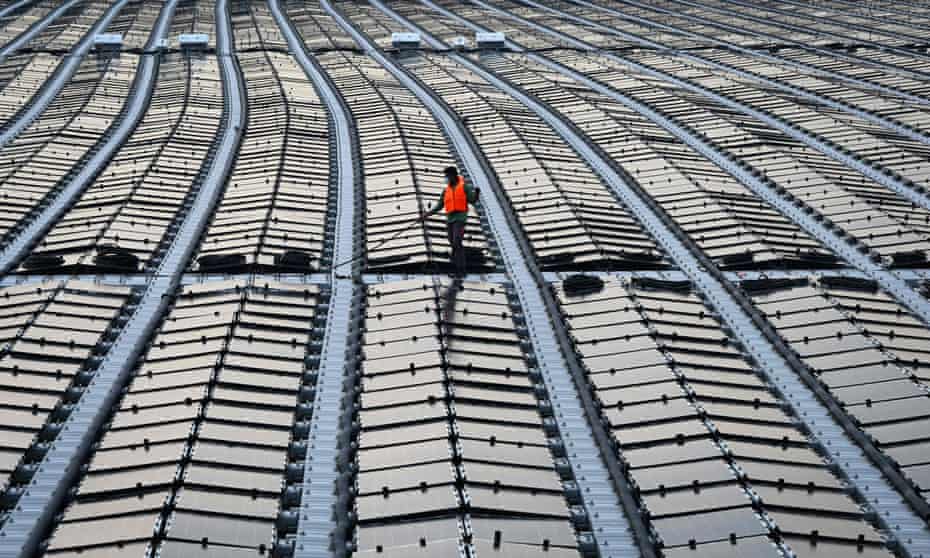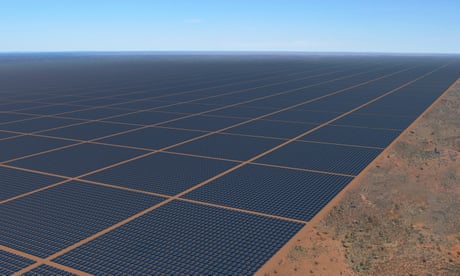Extract from The Guardian
Billionaires Mike Cannon-Brookes and Andrew Forrest’s investment accelerates company’s plans to explore similar plants in Australia and beyond.

The investment brings to about $250m the money raised to build a 17-gigawatt solar plant on a cattle property at Newcastle Waters, midway between Alice Springs and the Northern Territory’s capital.
The project would be a 12,000 hectare solar precinct with 17-20 GW solar generation and 36-42 GWh energy storage to enable 24/7 dispatchable electricity near Elliott, in the Northern Territory.
The funding “will take us all the way through to the financial close of the Australia-Asia PowerLink”, David Griffin, Sun Cable’s chief executive, said.
“It will also allow us to accelerate development of our broader portfolio,” he said. “Our mission is to supply renewable electricity from resource-abundant regions to growing load centres at scale.”
“Some of our subsequent projects will also rely on [technology] very similar in concept to the first project,” he said. “There’s a lot of opportunities in this area … but certainly we have more projects emanating from Australia as well.”
Griffin said there was no connection between Sun Cable’s plans, and the recent hostile takeover bid by Cannon-Brookes’ Grok Ventures and Canadian asset manager Brookfield of AGL Energy. The two suitors dropped their bid a week ago after AGL rejected a revised offer that valued AGL at just under $8.5bn, although AGL itself is not certain the two won’t be back for another tilt.
Sun Cable, declined to provide a breakdown of the contributions from Grok and Forrest’s Squadron Energy to the $210m raising, adding only that the original investors took up their full entitlements. Staff, who now number 80, also joined the list of shareholders, Griffin said.
“We’re just really stoked to close this round,” Griffin said. “It’s a really significant number and puts us in a really strong position.”
“Sun Cable’s vision will transform Australia’s capability to become a world-leading generator and exporter of renewable electricity and enable decarbonisation. I’m proud to be a cornerstone investor in Sun Cable, its team and its vision,” Forrest said.
Squadron Energy and Forrest’s Fortescue Future Industries were approached for comment.
The latter had a big week, landing Guy Debelle, the current deputy governor of the Reserve Bank of Australia to be its chief financial officer.

Debelle, who had been considered to be a frontrunner to replace current central bank governor Philip Lowe, will help steer the company’s plans to produce 15m tonnes of hydrogen produced by renewable energy a year by 2030 for global markets.
“Climate change has a broad-ranging impact on Australia, both in terms of geography and in terms of Australian businesses and households,” Debelle said in a statement after his surprise exit from the RBA.
“Australia has been an energy exporter for many decades,” he said. “Australia is also endowed with resources that have the potential for us to continue to be an exporter of energy – but renewable rather than emissions-intensive fossil fuels.”
Debelle’s now former boss, RBA governor Lowe, told a banking conference on Friday investors wanted a plan on how Australia would transition to a less carbon-intensive economy.
“They want to know what the opportunities Australia has and they want to talk about the risks that we have as well,” Lowe said, noting Debelle had resigned “to participate in those opportunities”.
Institutions such as the RBA and the Australian Prudential Regulation Authority were working on a framework to help markets measure, manage and price the risks as Australia shifted out of fossil fuels, he said. These included assessing climate vulnerability.
“We need to provide the people who want to make capital decisions with information, and it needs to be quality information,” Lowe said. “Australia [can] seize the fantastic opportunities we have in this area. That’s a huge challenge for the future.”
No comments:
Post a Comment